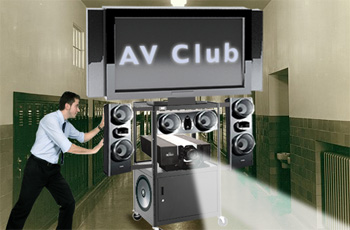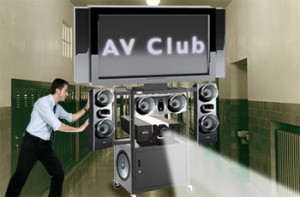Back to the (AV) Future
AV technology in  Education has made big advances over the last couple decades. It’s been (and continues to be) a great time to be involved with ProAV. And with spring upon us and “renewal” in the air, it’s exciting to consider new possibilities. But as we all know, to get to May flowers, we must make the best of April showers.
Education has made big advances over the last couple decades. It’s been (and continues to be) a great time to be involved with ProAV. And with spring upon us and “renewal” in the air, it’s exciting to consider new possibilities. But as we all know, to get to May flowers, we must make the best of April showers.
I‘ve been spending some rainy days going through and purging old paperwork. When doing so, two documents managed a further deferment of their trip to the recycle bin and got a quick re-read. Their stay of execution was actually due to their titles, being seemingly relevant to current hot AV in Education topics. The first, published in a trade magazine was titled, “How to Sell Videoconferencing Services within Your Organization.” The second, an academic paper authored by yours truly, was titled “Applying Telecommunications to Smart Classrooms.” Funny though — I couldn’t remember reading, let alone writing, either of them before!
Actually, the technical information contained within is quite unremarkable and not something I’m advancing here as recommended reading. But nonetheless, I was surprised (and even motivated) by a few points that were made, as well as the context in which they were written. I’ll hit the high points of these pieces for you and then offer what coming across them has got me thinking about.
First off, the “How to Sell Videoconferencing…” piece notes that a leading success indicator from those involved with videoconferencing was the actual usage (my emphasis) of videoconferencing systems. Further, they note, “The more it was used, the more successful it was perceived to be.” Well, like… Duh, you say! But, in fairness to the writer (Francine Crème Thuston), I’d have to say, and actually believe I’ve written so in this column previously, that on a whole, this technology really is still way underutilized. Anyways, Francine cites research (through one on one interviews) of 12 companies involved with videoconferencing and of those 12, eight mentioned saving time and associated travel expenses as justifications for the technology. Really? Another big Duhhhh! Also catching my eye was that Ms. Thuston asked them all what they would have done differently. Her summation of the feedback: all responded to a common theme of “better planning prior to implementation.” So the takeaways here: use the systems more and when putting them in, make sure to plan carefully. Hold those thoughts.
Now for the “Applying Telecommunications to Smart Classrooms” masterpiece (he says, tongue in cheek!). After a general overview of the concept and purpose of smart classrooms, I wrote that direct dial support phones, hard wired priority security systems, network based remote data/media retrieval are all conventional examples of telecommunications usage in such equipped classrooms. Do I hear more DUHS!? Well, yes, pretty basic tried and true stuff (even if I did write it). But, it’s really the date of authorship that makes this, and the above noted article, noteworthy here. But before I reveal that, how about this quote? “A future application would be to use the dial-up line to call a ‘smart’ classroom control panel, from the central playback site. This would allow staff to preconfigure the room equipment and facilities for an instructor, without running from room to room.” What was I thinking! Clearly the network would be a better avenue for connecting the rooms vs. lowly dial-up.
Ok, so when were these written? Well here is the interesting (and somewhat troubling) part. The first was published in Telecommunications magazine in the December 1992 issue. The second, handed in as a term paper, was written in April of 1993. Err, let’s see; that’d be about SEVENTEEN years ago! So much for current “hot” topics!
Sure, the technology has advanced almost amazingly over that time. But fundamentally, in context of what was being written so long ago, and what the current events and technology are dictating, it seems the design concepts driving them haven’t moved much at all. So, I offer to you, the AV Club: On at least these two topics, perhaps we’re really needing, and due, a paradigm shift in approaches.
On the videoconferencing front, instead of the conventional, “what rooms need what components to become videoconferencing capable?” shouldn’t the question (approach) be more like “what rooms don’t need to be VTC capable moving forward?” For the smart classroom telecommunications issue of “what kinds of telecommunications (network) services are needed to connect certain aspects of AV equipment?” shouldn’t our mindset be more like “what does the room AV wiring topology look like with all AV interconnected via telecommunications (network)?”
Oh, look! The sun is out. Just be sure to plan that garden carefully before we go outside.
The views expressed in this column do not necessarily reflect the views of the authors’ employer(s), past or present.
Greg Bronson, CTS-D, applies AV technologies in the development of innovative learning spaces for higher education. Greg spent the first 10 years of his career as AV technician and service manager, with the past 12+ years as an AV system designer and project manager. Bronson currently works for Cornell University and has also worked for two SUNY (State University of New York) campuses as well as a regional secondary education service depot. Bronson is the originator of concept for Infocomm’s Dashboard for Controls and has had completed projects featured in industry publications. You can reach Greg at gregthetechie@netscape.net





